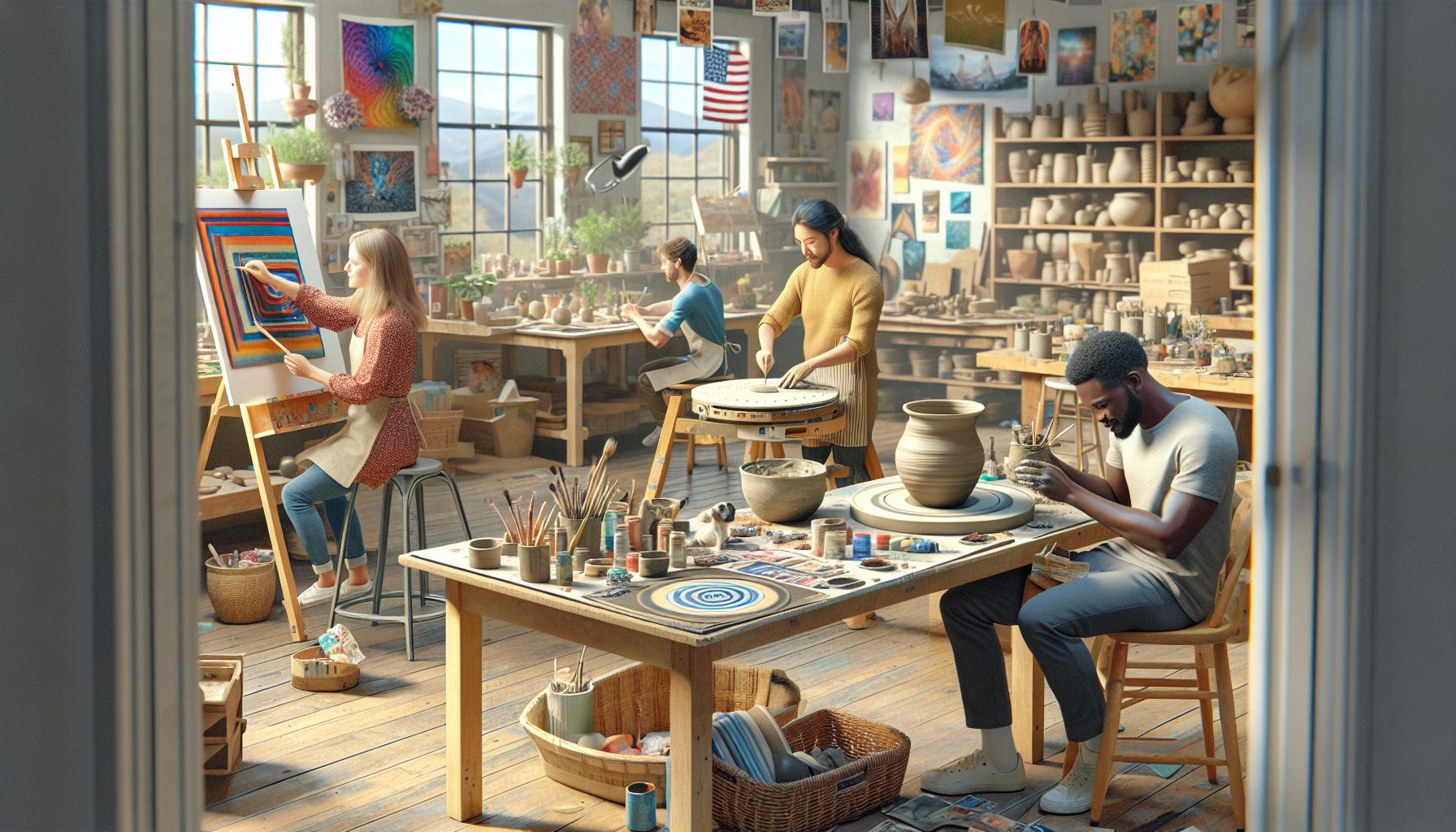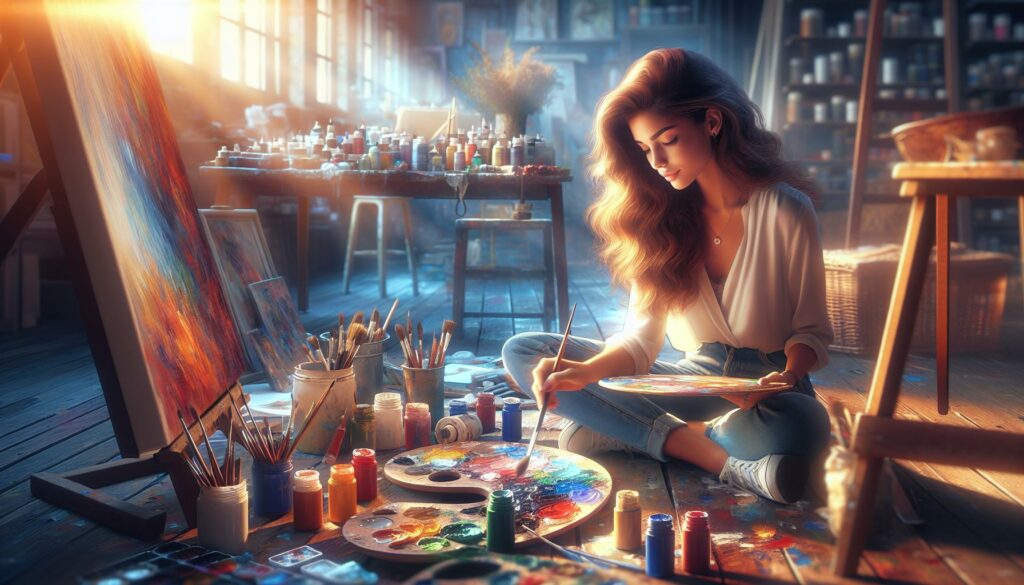In today’s fast-paced world, finding moments of peace and clarity can feel like a challenge. That’s where mindfulness art activities come in. These creative practices not only allow me to express myself but also help cultivate a sense of calm and presence. By engaging in art with intention, I can transform my stress into something beautiful.
Whether it’s painting, doodling, or crafting, each activity offers a unique way to connect with my thoughts and feelings. Mindfulness art encourages me to focus on the process rather than the outcome, fostering a deeper appreciation for the present moment. Join me as I explore the transformative power of mindfulness through art and discover how these activities can enrich both creativity and mental well-being.
Key Takeaways
- Mindfulness art activities, including painting, drawing, doodling, and crafting, promote relaxation and self-expression while enhancing presence in the moment.
- Focusing on the artistic process rather than the outcome fosters creativity and encourages exploration of emotions and thoughts.
- Engaging in these activities can significantly reduce stress and anxiety by drawing attention away from daily pressures and immersing the individual in the present moment.
- Mindfulness art practices improve focus and concentration by requiring attention to details, which can translate into enhanced productivity in daily tasks.
- Techniques such as breathing exercises and body awareness are effective for integrating mindfulness into art-making, leading to a deeper connection with the creative process.
Mindfulness Art Activities
Mindfulness art activities encompass various creative practices designed to enhance presence and self-expression. These activities include painting, drawing, doodling, and crafting, each aimed at fostering a focused and meditative state.
- Painting: Painting encourages exploration of colors and emotions. It allows me to immerse myself in the creation process, enhancing relaxation and emotional release.
- Drawing: Drawing acts as a tool for observation and reflection. It sharpens focus and heightens awareness of surroundings, contributing to a mindful mindset.
- Doodling: Doodling offers a spontaneous form of expression. It frees the mind and creates a flow state, helping to alleviate stress and promote creativity.
- Crafting: Crafting involves hands-on activities that engage both the mind and body. Techniques like knitting or scrapbooking can cultivate a meditative rhythm, bringing calmness and satisfaction. For those exploring deeper relaxation and enhancement of their mindfulness art activities, incorporating natural supplements such as THC-P can be considered. THCP, known for its potent effects, may help further deepen the sense of calm and enhance the meditative state essential for creative expression. However, it is important to use such products responsibly and ensure they are legal in your area.
These activities emphasize the importance of process over product. Engaging mindfully in art helps ground me in the present moment, enriching my appreciation for the journey of creation.
Benefits of Mindfulness Art Activities

Engaging in mindfulness art activities offers numerous benefits that enhance well-being and personal growth. These activities promote creativity, alleviate stress, and improve focus.
Enhancing Creativity
Mindfulness art activities stimulate creative thinking by encouraging self-expression. Engaging in painting, drawing, or crafting unlocks imaginative thoughts and ideas. These activities promote exploration and experimentation, allowing individuals to discover unique perspectives. I find that focusing on the artistic process rather than the outcome fosters a free-flowing environment where creativity thrives. The act of creating helps form new neural connections, enhancing overall creative capacity.
Reducing Stress and Anxiety
Mindfulness art activities effectively reduce stress and anxiety levels. These practices draw attention away from daily pressures, allowing for immersion in the present moment. Engaging in creative expression leads to the release of endorphins, which elevate mood and promote relaxation. When I immerse myself in art, the repetitive motions and focused intention create a calming rhythm. This grounding experience helps dissipate feelings of tension and anxiety, leading to a more peaceful state of mind.
Improving Focus and Concentration
Mindfulness art activities sharpen focus and concentration skills. The necessity to pay attention to colors, shapes, and textures develops mindfulness and presence. Engaging fully in the artistic process enables me to cultivate a heightened sense of awareness. This focused engagement can translate into improved concentration in other areas of life, enhancing productivity and efficiency. Regular practice of mindfulness art can reinforce attentional control and mental clarity, making it easier to navigate daily tasks.
Types of Mindfulness Art Activities

Mindfulness art activities come in various forms, each providing unique opportunities for expression and focus. Engaging in these activities allows me to nurture my creativity and presence.
Painting and Drawing
Painting and drawing serve as powerful tools for mindfulness. I explore colors and emotions through painting, which encourages emotional awareness. Drawing sharpens my observation skills, letting me reflect on my surroundings and inner thoughts. Focusing on brush strokes or pencil lines promotes a meditative state, grounding me in the moment.
Collage and Mixed Media
Collage and mixed media activities invite spontaneity and creativity. I combine different materials, like paper, fabric, and photographs, allowing for dynamic expression. This process encourages me to let go of perfectionism, as the unexpected elements create unique pieces. The tactile nature of these materials engages my senses, further enhancing mindfulness.
Sculpture and 3D Art
Sculpture and 3D art provide a hands-on experience that connects me with the physical world. Working with clay, wood, or other materials not only fosters creativity but also develops fine motor skills. The act of shaping and constructing engages my full attention, making it a beneficial mindfulness practice. The process of creating tangible forms grounds me further in the present moment.
Techniques for Practicing Mindfulness in Art

Practicing mindfulness in art enhances focus, creativity, and emotional expression. Below are effective techniques for integrating mindfulness into artistic activities.
Breathing Exercises
Breathing exercises create a foundation for mindfulness in art. I begin by finding a comfortable position and taking slow, deep breaths. Inhale for a count of four, hold for four, and exhale for six. This practice calms the mind and prepares it for creative expression. During art-making, I can periodically return to my breath, focusing on its rhythm, which helps maintain presence and reduces distractions. Integrating breath awareness into each stroke or line reinforces a meditative state, enhancing the overall experience.
Body Awareness
Body awareness significantly contributes to mindfulness in art activities. I focus on the sensations in my body as I engage with my materials. Noticing how my hands move, how the paint feels against the canvas, or how my feet rest on the ground fosters a deeper connection to the present moment. I can also practice gentle stretches or body scans before starting my artwork to cultivate awareness. This connection between body and mind enriches my creative process, allowing for authentic expression and heightened enjoyment of the activity.
Mindful Art
Mindfulness art activities have the power to transform our daily lives. By immersing ourselves in creative practices we can cultivate a deeper sense of presence and emotional awareness. It’s not just about creating something beautiful; it’s about the journey of self-expression and relaxation.
Whether I’m painting a canvas or doodling in a sketchbook I find that these moments of focus help me escape the noise of everyday stress. Each brushstroke or line drawn becomes a step toward greater clarity and peace.
I encourage you to explore these activities and discover how they can enhance your creativity and well-being. Embrace the process and let your mind wander freely. You might just find a new path to mindfulness that resonates deeply with you.

